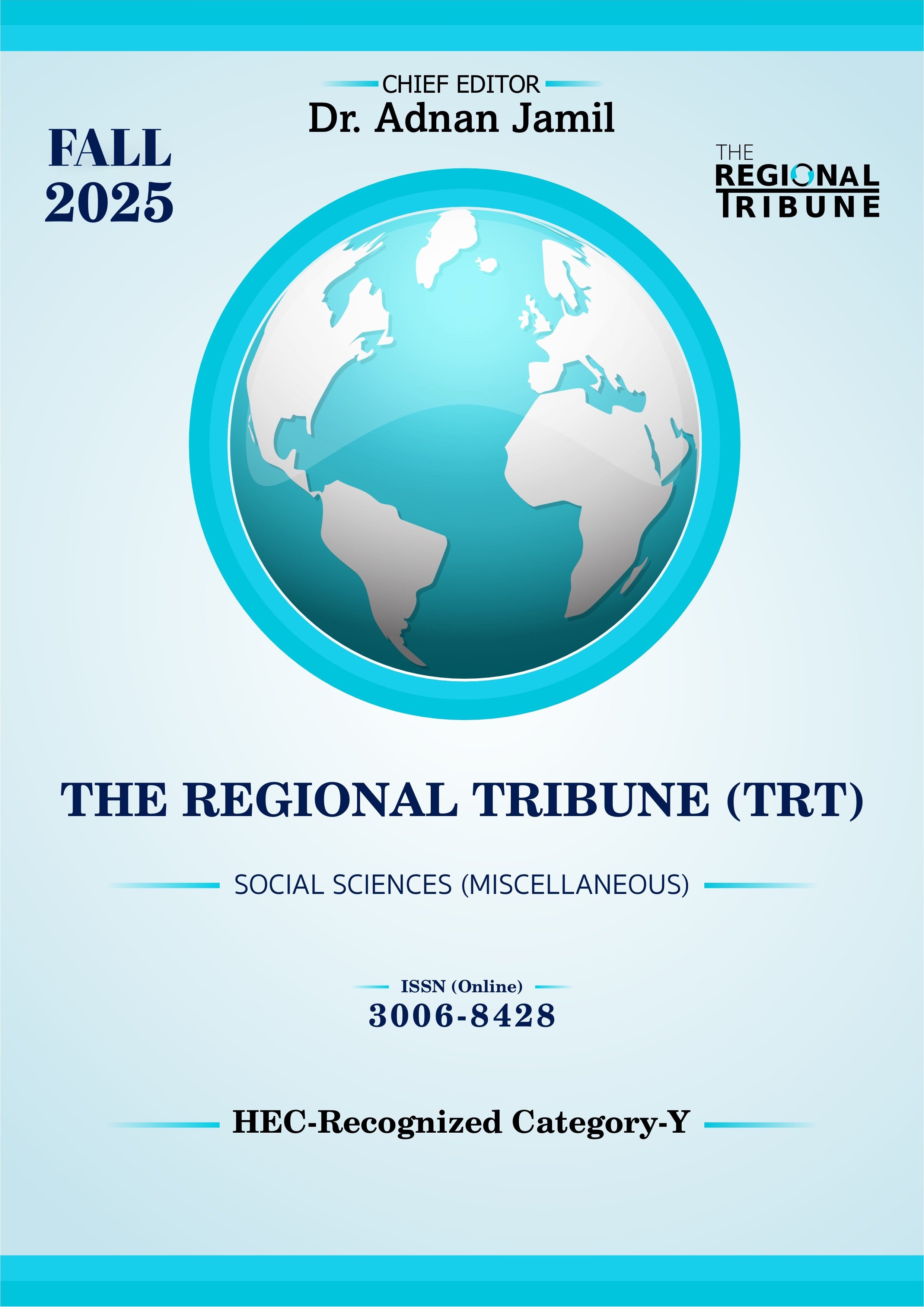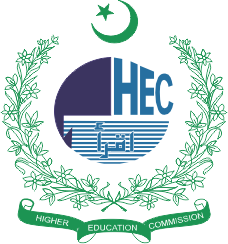Income Inequality and Globalization: A New Perspective with Respect to Ethnic and Religious Diversification
DOI:
https://doi.org/10.55737/trt/FL25.126Keywords:
Inequality, Gini Coefficient, KOF Globalization, Ethnic, ReligiousAbstract
Globalization impact on income inequality remains in debates since the advantages of liberalization had been realized by the world over mercantilism. The current study focuses on how globalization has impacted nation’s income inequality which are ethically and religiously homogeneous verses heterogeneous. The study examines relationships by using the data of 48 countries for the period of (1990-2022). The countries have been bifurcated in two groups; one with high ethnic and religious diversification and other with low. Driscoll-Kraay standard errors linear regression model was applied to examine the relationship. Our research disclosed unconventional findings; KOF-globalization positively influences the Gini-inequality in homogeneous countries but in heterogenous nations the relationship is inverse. Secondly, HDI and GDP per capita shows mere impacts as compared to Urbanization and Governance quality driving the inequality in real terms. Conclusively, higher ethnic-religious diversified nations look better off compared to less diversified nations in handling impact of globalization on inequality. As policy recommendation we urge countries to frame their counter-inequality policies by giving due weight to social demography. It warrants further investigation to dig deeper into contrasting relationships between globalization and income inequality in back drop of ethnic-religious diversification.
References
Ahmad, F., & Khan, R. A. (2015). A power comparison of various normality tests. Pakistan Journal of Statistics and Operation Research, 11(3), 331-345. https://doi.org/10.18187/pjsor.v11i3.845
Ajide, K. B., & Ibrahim, R. L. (2022). Environmental impacts of income inequality: Evidence from G7 economies. Environmental Science and Pollution Research, 29(2), 1887-1908. https://doi.org/10.1007/s11356-021-15720-6
Apel, H. (2020). Inequality in development: The 2030 Agenda, SDG 10 and the role of redistribution. Real-World Econ. Rev, 92, 228-237. http://acdc2007.free.fr/whole92.pdf#page=228
Atkinson, A. (2013). Reducing income inequality in Europe. IZA Journal of European Labor Studies, 2(1), 12. https://doi.org/10.1186/2193-9012-2-12
Bai, J., Choi, S. H., & Liao, Y. (2021). Feasible generalized least squares for panel data with cross-sectional and serial correlations. Empirical Economics, 60(1), 309-326. https://doi.org/10.1007/s00181-020-01977-2
Beck, N. (2001). Time‐series–cross‐section data. Statistica Neerlandica, 55(2), 111-133. https://doi.org/10.1111/1467-9574.00161
Biswas, S., Chakraborty, I., & Hai, R. (2017). Income inequality, tax policy, and economic growth*. The Economic Journal, 127(601), 688-727. https://doi.org/10.1111/ecoj.12485
Breusch, T. S., & Pagan, A. R. (1980). The Lagrange multiplier test and its applications to model specification in econometrics. The Review of Economic Studies, 47(1), 239-253. https://doi.org/10.2307/2297111
Cammeraat, E. (2020). The relationship between different social expenditure schemes and poverty, inequality and economic growth. International Social Security Review, 73(2), 101-123. https://doi.org/10.1111/issr.12236
Chancel, L., Piketty, T., Saez, E., & Zucman, G. (Eds.). (2022). World inequality report 2022. Harvard University Press.
Daoud, J. I. (2017). Multicollinearity and regression analysis. Journal of Physics: Conference Series, 949, 012009. https://doi.org/10.1088/1742-6596/949/1/012009
Deardorff, A. V. (1994). Overview of the Stolper-Samuelson theorem. Deardorff and Stern, eds, 7-34.
Dix-Carneiro, R., & Traiberman, S. (2023). Globalization, trade imbalances and inequality. Journal of Monetary Economics, 133, 48-72. https://doi.org/10.1016/j.jmoneco.2022.10.002
Dorn, F., Fuest, C., & Potrafke, N. (2022). Trade openness and income inequality: New empirical evidence. Economic Inquiry, 60(1), 202-223. https://doi.org/10.1111/ecin.13018
Dreher, A. (2006). Does globalization affect growth? Evidence from a new index of globalization. Applied Economics, 38(10), 1091-1110. https://doi.org/10.1080/00036840500392078
Driscoll, J. C., & Kraay, A. C. (1998). Consistent covariance matrix estimation with spatially dependent panel data. Review of Economics and Statistics, 80(4), 549-560. https://doi.org/10.1162/003465398557825
Dziuban, C. D., & Shirkey, E. C. (1974). When is a correlation matrix appropriate for factor analysis? Some decision rules. Psychological Bulletin, 81(6), 358-361. https://doi.org/10.1037/h0036316
Factbook, C. s. W. (2022). Field Listing-Ethnic groups. https://www.cia.gov/the-world-factbook/about/archives/2022/field/ethnic-groups/
Fearon, J. D. (2003). Ethnic and cultural diversity by country. Journal of Economic Growth, 8(2), 195-222. https://doi.org/10.1023/a:1024419522867
Felbermayr, G. J., & Licandro, O. (2005). The underestimated virtues of the two-sector AK model. Topics in Macroeconomics, 5(1). https://doi.org/10.2202/1534-6005.1322
Fisher, M. J., & Marshall, A. P. (2009). Understanding descriptive statistics. Australian Critical Care, 22(2), 93-97. https://doi.org/10.1016/j.aucc.2008.11.003
Friedman, M. (1937). The use of ranks to avoid the assumption of normality implicit in the analysis of variance. Journal of the American Statistical Association, 32(200), 675-701. https://doi.org/10.1080/01621459.1937.10503522
Haldar, A., & Sethi, N. (2023). The effects of renewable energy, innovation, and governance on climate change and economic growth—Investigating the opportunities and challenges for emerging Asia. Asian Economics Letters, 4(2). https://doi.org/10.46557/001c.73683
Hartmann, D., Bezerra, M., Lodolo, B., & Pinheiro, F. L. (2020). International trade, development traps, and the core-periphery structure of income inequality. Economia, 21(2), 255-278. https://doi.org/10.1016/j.econ.2019.09.001
Hasell, J. (2023). Measuring inequality: what is the Gini coefficient?. Our World in Data. https://ourworldindata.org/what-is-the-gini-coefficient
Hausman, J. A. (1978). Specification tests in econometrics. Econometrica, 46(6), 1251. https://doi.org/10.2307/1913827
Huh, H., & Park, C. (2021). A new index of globalisation: Measuring impacts of integration on economic growth and income inequality. The World Economy, 44(2), 409-443. https://doi.org/10.1111/twec.12998
Hui, Y., & Bhaumik, A. (2023). Economic globalization and income inequality: A review. Asia-Pacific Journal of Management and Technology, 03(04), 01-09. https://doi.org/10.46977/apjmt.2023.v03i04.001
Huynh, C. M. (2021). Foreign direct investment and income inequality: Does institutional quality matter? The Journal of International Trade & Economic Development, 30(8), 1231-1243. https://doi.org/10.1080/09638199.2021.1942164
Ikechukwu, I. F., Fyneface, P., & Anochie, C. (2022). Assessing The Concept of Heckscher Ohlin Model. BW Academic Journal, 7-7. https://mail.bwjournal.org/index.php/bsjournal/article/view/956
Jahanger, A., Usman, M., Murshed, M., Mahmood, H., & Balsalobre-Lorente, D. (2022). The linkages between natural resources, human capital, globalization, economic growth, financial development, and ecological footprint: The moderating role of technological innovations. Resources Policy, 76, 102569. https://doi.org/10.1016/j.resourpol.2022.102569
Jaumotte, F., Lall, S., & Papageorgiou, C. (2013). Rising income inequality: Technology, or trade and financial globalization? IMF Economic Review, 61(2), 271-309. https://doi.org/10.1057/imfer.2013.7
Jermsittiparsert, K. (2021). Does urbanization, industrialization, and income unequal distribution lead to environmental degradation? Fresh evidence from ASEAN. International Journal of Economics and Finance Studies, 13(2), 253-272.
Kaur, P., Stoltzfus, J., & Yellapu, V. (2018). Descriptive statistics. International Journal of Academic Medicine, 4(1), 60. https://doi.org/10.4103/ijam.ijam_7_18
Khan, M. A., Walmsley, T., & Mukhopadhyay, K. (2021). Trade liberalization and income inequality: The case for Pakistan. Journal of Asian Economics, 74, 101310. https://doi.org/10.1016/j.asieco.2021.101310
KOF Globalisation Index. (2023). ETH Zurich. https://kof.ethz.ch/en/forecasts-and-indicators/indicators/kof-globalisation-index.html
Kraay, D. K. a. A. (2023). The Worldwide Governance Indicator.
Kunawotor, M. E., Bokpin, G. A., & Barnor, C. (2020). Drivers of income inequality in Africa: Does institutional quality matter? African Development Review, 32(4), 718-729. https://doi.org/10.1111/1467-8268.12473
Law, S. H., Naseem, N., Lau, W. T., & Trinugroho, I. (2020). Can innovation improve income inequality? Evidence from panel data. Economic Systems, 44(4), 100815. https://doi.org/10.1016/j.ecosys.2020.100815
Leamer, E. E. (1995). The Heckscher-Ohlin model in theory and practice. In: International Finance Section, Department of Economics, Princeton University.
Madni, G. R. (2019). Probing institutional quality through ethnic diversity, income inequality and public spending. Social Indicators Research, 142(2), 581-595. https://doi.org/10.1007/s11205-018-1924-1
Mahbub-ul-Haq. (1995). Reflections on human development. oxford university Press.
Mallick, H., Mahalik, M. K., & Padhan, H. (2020). Does globalization exacerbate income inequality in two largest emerging economies? The role of FDI and remittances inflows. International Review of Economics, 67(4), 443-480. https://doi.org/10.1007/s12232-020-00350-0
Munir, K., & Sultan, M. (2017). Macroeconomic determinants of income inequality in India and Pakistan. Theoretical & Applied Economics, 24(4). https://www.ebsco.ectap.ro/Theoretical_&_Applied_Economics_2017_Winter.pdf#page=109
Munir, K., & Bukhari, M. (2020). Impact of globalization on income inequality in Asian emerging economies. International Journal of Sociology and Social Policy, 40(1/2), 44-57. https://doi.org/10.1108/ijssp-08-2019-0167
Muntaner, C., Lynch, J., & Oates, G. L. (2020). The social class determinants of income inequality and social cohesion. The Political Economy of Social Inequalities, 367-399. https://doi.org/10.4324/9781315231051-22
Naveed, A., & Wang, C. (2018). Can religion explain cross-country differences in inequality? A global perspective. Social Choice and Welfare, 50(3), 481-518. https://doi.org/10.1007/s00355-017-1093-1
Ozyilmaz, A., Bayraktar, Y., Isik, E., Toprak, M., Olgun, M. F., Aydin, S., & Guloglu, T. (2022). The impact of refugees on income inequality in developing countries by using Quantile regression, ANN, fixed and random effect. Sustainability, 14(15), 9223. https://doi.org/10.3390/su14159223
Pesaran, M. H. (2007). A simple panel unit root test in the presence of cross‐section dependence. Journal of Applied Econometrics, 22(2), 265-312. https://doi.org/10.1002/jae.951
PRC. (2018). The Age Gap in Religion Around the World.
Religion by Country. (2024). World Population Review. https://worldpopulationreview.com/country-rankings/religion-by-country
Rudra, N. (2004). Openness, welfare spending, and inequality in the developing world. International Studies Quarterly, 48(3), 683-709. https://doi.org/10.1111/j.0020-8833.2004.00320.x
Silva, J. A., & Leichenko, R. M. (2004). Regional income inequality and international trade. Economic Geography, 80(3), 261-286. https://doi.org/10.1111/j.1944-8287.2004.tb00235.x
Steiger, J. H. (1980). Tests for comparing elements of a correlation matrix. Psychological Bulletin, 87(2), 245-251. https://doi.org/10.1037//0033-2909.87.2.245
Topuz, S. G. (2022). The relationship between income inequality and economic growth: Are transmission channels effective? Social Indicators Research, 162(3), 1177-1231. https://doi.org/10.1007/s11205-022-02882-0
UNdata. (2023). Demographic Statistics Database http://data.un.org/Explorer.aspx
UNDP. (2023). Human Development Index: Human Development Report https://hdr.undp.org/data-center/documentation-and-downloads
Villanthenkodath, M. A., Pal, S., & Mahalik, M. K. (2023). Income inequality in globalization context: Evidence from global data. Journal of the Knowledge Economy, 15(1), 3872-3902. https://doi.org/10.1007/s13132-023-01342-5
Wade, R. H. (2020). Is globalization reducing poverty and inequality? In Neoliberalism, Globalization, and Inequalities (pp. 143-176). Routledge.
Westerlund, J. (2007). Testing for error correction in panel data. Oxford Bulletin of Economics and Statistics, 69(6), 709-748. https://doi.org/10.1111/j.1468-0084.2007.00477.x
Westerlund, J., & Edgerton, D. L. (2008). A simple test for Cointegration in dependent panels with structural breaks. Oxford Bulletin of Economics and Statistics, 70(5), 665-704. https://doi.org/10.1111/j.1468-0084.2008.00513.x
White, H. (1980). A heteroskedasticity-consistent covariance matrix estimator and a direct test for Heteroskedasticity. Econometrica, 48(4), 817. https://doi.org/10.2307/1912934
Wooldridge, J. M. (2003). Diagnostic testing. A Companion to Theoretical Econometrics, 180-200. https://doi.org/10.1002/9780470996249.ch10
World Bank. (2015). World Development Indicators | DataBank. Worldbank.org. https://databank.worldbank.org/indicator/NY.GDP.PCAP.CD/1ff4a498/Popular-Indicators
WorldBank. (2022). The Worldwide Governance Indicator.
Yang, B., Ali, M., Hashmi, S. H., & Jahanger, A. (2022). Do income inequality and institutional quality affect CO2 emissions in developing economies? Environmental Science and Pollution Research, 29(28), 42720-42741. https://doi.org/10.1007/s11356-021-18278-5
Zhan, P., Ma, X., & Li, S. (2021). Migration, population aging, and income inequality in China. Journal of Asian Economics, 76, 101351. https://doi.org/10.1016/j.asieco.2021.101351
Downloads
Published
Issue
Section
License
Copyright (c) 2025 Mirza Khawar Baig, Dr. Rao Muhammad Atif

This work is licensed under a Creative Commons Attribution-NonCommercial 4.0 International License.



